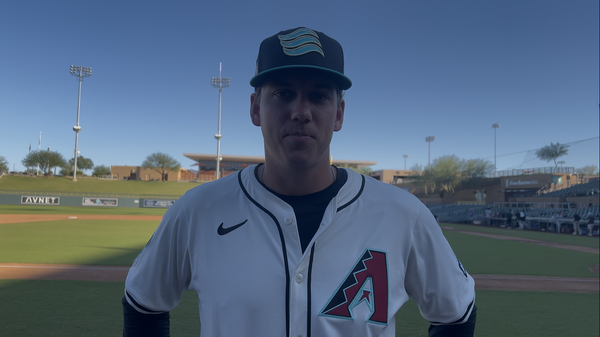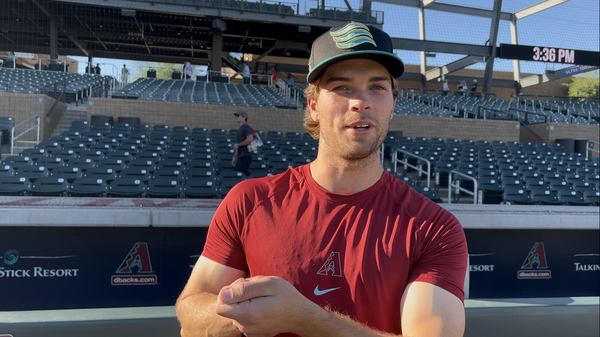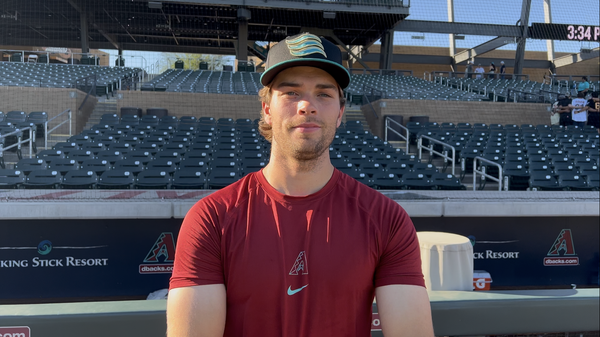Breaking Down Hayden Durke's Unfair Stuff
With Statcast data now available for Durke, who made his Triple-A debut Tuesday, we can start projecting how it plays at the major league level.
Diamondbacks reliever prospect Hayden Durke is flying up the system this season. Tuesday night marked his Triple-A debut, which is downright impressive considering he opened the season in High-A Hillsboro.
At this point of the season, I have Durke as the third-best pitching prospect in Arizona’s system behind starters Cristian Mena and Daniel Eagen. He profiles as a potential back-of-the-bullpen arm due to his ability to miss bats with a minor semblance of control. Drafted in the 13th round of the 2023 MLB Draft, he actually got the largest signing bonus ($350K) out of all the arms the D-backs took.
Now that he’s in Reno, we can take a look at the Statcast metrics to get a better profile of his unfair stuff.
Pitch Shapes and Velocity
His four-seamer sat 93-96 MPH in his first outing with the Aces. He’s been clocked as high as 98.0 MPH with Amarillo. The pitch gets a decent amount of ride, with 12-16” of induced vertical break. It carries a very vertical shape, with 0-5” horizontal break.
At first glance, it seems average, but keep in mind the game was played in Reno. Higher elevation reduces the effect of spin on the baseball, with University of Illinois physics professor Alan Nathan writing about this back in 2007. Reno is at 4,500 feet elevation while Coors Field is about 5,000 feet (they have a line of seats that are measured at one mile above sea level in the ballpark).
With an average iVB of 13.1”, we can project Durke’s fastball to average around 16” iVB around sea level. That’s slightly above-average ride, although we should also double-check when he pitches on the road, since those are real not projected measurements.
The slider takes on a “death ball” shape, with all three of them having negative induced vertical break (-1 to -4 inches). A death ball is a slider with a lot of depth (negative vert) and very little sweep. Due to the lack of horizontal movement, it doesn’t have as big a platoon split as a traditional slider or sweeper. Because of its weird shape, it has the potential to produce a lot of whiffs.
Durke’s three sliders measured in at 84-86 MPH with 0, 0, and 1” horizontal break. I don’t have the full data from his time in Hillsboro and Amarillo, but watching him pitch on the minor league broadcasts, the slider is his best swing-and-miss pitch. It explains why he produced a 19.9% swinging strike rate in Double-A.
The third and final pitch of his arsenal is the curveball. Despite the hard velocity, it gets a lot of vertical movement. His two curveballs clocked in at 83.1 and 84.6 MPH, but also got -12 and -14” induced vertical break. At the major league level, we can add another three inches of drop to the pitch.
From the pitch shape profile, it’s pretty clear his path to success is being able to stretch the strike zone vertically. With a fastball that gets solid, not great ride, plus two “depthy” breaking balls, it will come down to his ability to disguise and tunnel them consistently. Considering his track record this season, that seems to be the case.
Major League Projection
- 4-Seam Fastball: 94-98 MPH, 16” iVB, 4” arm-side HB
- Slider: 84-88 MPH, -4” iVB, 2” glove-side HB
- Curveball: 83-85 MPH, -15” iVB, 5” glove-side HB
If we wanted to project how Durke would look at the major league level, the one pitcher that comes to mind is Toronto Blue Jays’ right-hander Braydon Fisher in terms of stuff. Both pitchers have solid ride on their fastballs, a death ball slider, and a depthy curveball at high velocity. The approach might be different, as Fisher throws breaking balls almost 80% of the time, and Durke is still a heavy fastball user in the minor leagues.
As Durke gets more outings in Triple-A, we should be able to project more confidently how he’ll fare at the major league level. He’s a potential call-up candidate for 2026, although if the bullpen suffers more injuries, he could arrive sooner rather than later.



